Effect of Lubricant Young’s Modulus on Surface Settlement Control During Pipe-Roof Construction Using Pipe-Jacking Method
Abstract
:1. Introduction
2. Numerical Model Establishment and Validation
2.1. Case Overview
2.2. Numerical Model Setup
2.3. Validation Result and Influence Mechanism of Lubricant Young’s Modulus
3. Analysis of Influencing Factors of Surface Settlement
3.1. Modeling Schemes
3.2. Influence of Different Burial Depths on the Lubricant Controlling Effect
3.3. Influence of Arrangement Scheme on the Lubricant Controlling Effect
3.4. Influence of Tail Void on the Lubricant Controlling Effect
4. Conclusions
- In general, increased surface settlement is observed with greater burial depths and larger tail voids. Moreover, a V-shaped transverse settlement trough, characterized by higher surface displacement, is caused by the gate-shaped system, while a U-shaped transverse settlement trough, associated with lower surface displacement, is induced by the horseshoe-shaped system;
- Typically, increasing the tail void and burial depth diminishes the lubricant’s ability to control surface settlement, whereas the horseshoe-shaped system is more conducive to effective control (compared with the gate-shaped system). Under these three cases, augmenting the lubricant Young’s modulus can reduce surface settlement to a greater extent;
- Lubricants manifest their control effect by influencing the interaction among adjacent pipelines. Broadly speaking, increasing the lubricant Young’s modulus more efficiently suppresses the repeated disturbance effect or enhances the shielding effect between each pair of adjacent pipelines, thereby providing better control over the surface settlement induced by pipe-roof construction. This effect is especially pronounced in soft soil layers.
Author Contributions
Funding
Institutional Review Board Statement
Informed Consent Statement
Data Availability Statement
Acknowledgments
Conflicts of Interest
References
- Sterling, R.L. Developments and research directions in pipe jacking and microtunneling. Undergr. Space 2020, 5, 1–19. [Google Scholar] [CrossRef]
- Li, R.; Zhang, D.; Wu, P.; Fang, Q.; Li, A.; Cao, L. Combined Application of Pipe Roof Pre-SUPPORT and Curtain Grouting Pre-Reinforcement in Closely Spaced Large Span Triple Tunnels. Appl. Sci. 2020, 10, 3186. [Google Scholar] [CrossRef]
- Hao, Z.; Zhang, H.; Zhang, G.; Xiong, W.; Wang, L. The Prediction of Ground Settlement of a Box Culvert Jacked Under the Action of an Ultra-Shallow Buried Pipe Curtain. Arab. J. Sci. Eng. 2022, 47, 12423–12438. [Google Scholar] [CrossRef]
- Zhou, H.; Huang, S.; Zhang, P.; Ma, B.; Ma, P.; Feng, X. Prediction of jacking force using PSO-BPNN and PSO-SVR algorithm in curved pipe roof. Tunn. Undergr. Space Technol. 2023, 138, 105159. [Google Scholar] [CrossRef]
- Bai, Q.; Zhao, W.; Cao, W.; Jia, P.; Cheng, C.; Lu, B. Test and Numerical Simulation of Excavation of Subway Stations Using the Small Pipe–Roof–Beam Method. Int. J. Geomech. 2023, 23, 04023018. [Google Scholar] [CrossRef]
- He, J.; Liao, S.; Tan, Y.; Liu, M. Analytical Study on the Ground Settlement Induced by Pipe-roof Tunnelling Considering the Interaction between Socketed Pipes. KSCE J. Civ. Eng. 2022, 27, 417–430. [Google Scholar] [CrossRef]
- Zhang, P.; Ma, B.; Zeng, C.; Xie, H.; Li, X.; Wang, D. Key techniques for the largest curved pipe jacking roof to date: A case study of Gongbei tunnel. Tunn. Undergr. Space Technol. 2016, 59, 134–145. [Google Scholar] [CrossRef]
- Liu, J.; Ma, B.; Cheng, Y. Design of the Gongbei tunnel using a very large cross-section pipe-roof and soil freezing method. Tunn. Undergr. Space Technol. 2018, 72, 28–40. [Google Scholar] [CrossRef]
- Feng, J.; Tan, Y.; Zhang, J.; Ma, K.; Dai, Y.; Yao, S. Evolution mechanism of axial force of super-long pipe roof. J. Civ. Struct. Health Monit. 2024, 14, 527–544. [Google Scholar] [CrossRef]
- Musso, G. Jacked Pipe Provides Roof for Underground Construction in Busy Urban Area. Civil Eng. 1979, 49, 79–82. [Google Scholar]
- Jia, P.; Zhao, W.; Khoshghalb, A.; Ni, P.; Jiang, B.; Chen, Y.; Li, S. A new model to predict ground surface settlement induced by jacked pipes with flanges. Tunn. Undergr. Space Technol. 2020, 98, 103330. [Google Scholar] [CrossRef]
- Ma, P.; Shimada, H.; Sasaoka, T.; Hamanaka, A.; Dintwe, T.K.M.; Pan, D. Investigation on the Performance of Pipe Roof Method Adjacent to the Underground Construction. Geotech. Geol. Eng. 2021, 39, 4677–4687. [Google Scholar] [CrossRef]
- Yang, S.-S.; Zhang, D.-W.; Wang, M.; Xu, J.-M.; Shen, C.; Zhang, C.-Z. Ground settlement caused by pipe-roof pre-construction method: Effect of the sequence of jacking pipe groups. J. Cent. South Univ. 2024, 31, 576–588. [Google Scholar] [CrossRef]
- Tang, Z.; Wang, H.-X.; Sun, D.-A.; Zhang, X. Surface displacement during pipe roof construction of pipe-jacking group with large section. Rock Soil Mech. 2022, 43, 9. [Google Scholar] [CrossRef]
- Ma, M.; Han, L.; Wu, Y.; Li, Q.; Zhang, Y. Behavioral Investigations of Three Parallel Large Reinforced Concrete Circular Pipes with the Construction of Pipe Jacking. Appl. Sci. 2023, 13, 8901. [Google Scholar] [CrossRef]
- Liu, B.; Jie, J.; Gao, Y.; Tian, X. Study on the Influence of Large Section Rectangular Pipe Jacking Construction on Soil Deformation. In Proceedings of the 2022 8th International Conference on Hydraulic and Civil Engineering: Deep Space Intelligent Development and Utilization Forum (ICHCE), Xi’an, China, 25–27 November 2022; pp. 773–776. [Google Scholar]
- Maehara, K.; Shimada, H.; Sasaoka, T.; Hamanaka, A. Development of Filling Material with Fly Ash and Slag as Lubricant in Pipe Jacking Under Acid Sulfate Soils. In Proceedings of the International Conference on Environment and Mineral Processing (EAMP), Ostrava, Czech Republic, 30 May–1 June 2019; pp. 115–119. [Google Scholar]
- Shimada, H.; Khazaei, S.; Kikuo, M. Small diameter tunnel excavation method using slurry pipe-jacking. Geotech. Geol. Eng. 2004, 22, 161–186. [Google Scholar]
- Zhou, S.; Wang, Y.; Huang, X. Experimental study on the effect of injecting slurry inside a jacking pipe tunnel in silt stratum. Tunn. Undergr. Space Technol. 2009, 24, 466–471. [Google Scholar] [CrossRef]
- Liu, S.; Zhang, B.; Zhang, X.; Fan, D.; Wang, H.; Yu, M. Formulation optimization and performance analysis of the thixotropic slurry for large-section rectangular pipe jacking in anhydrous sand. Constr. Build. Mater. 2022, 357, 129380. [Google Scholar] [CrossRef]
- Li, M.; Yang, J.; Zeng, L.; Jin, J.; Liu, Y. Case Study on the Interaction Between Rectangular Pipe Jacking Control and Ground Settlement in Silty Clay. Int. J. Civ. Eng. 2023, 21, 1447–1462. [Google Scholar] [CrossRef]
- Liu, J.; Cheng, H.; Cai, H.; Wang, X.; Feng, D. Design and Analysis of Grouting Pressure in Slurry Pipe Jacking Based on the Surrounding Soil Stability Mechanical Characteristics. Geofluids 2022, 2022, 1–17. [Google Scholar] [CrossRef]
- Qian, D.; Jiao, H.; Li, Z.; Zhu, Y.; Liu, J.; Chen, Z.; Gao, X.; Liu, H.; Tao, B.; Xu, Z. Ground Settlement Law, Jacking Force Prediction, and Control Countermeasures for Large-Section Rectangular Pipe Jacking of National Highway Underpass. Sustainability 2023, 15, 2888. [Google Scholar] [CrossRef]
- She, F.; Wu, Z.; Zhou, W.; Liu, G.; Li, L. Deformation control of surrounding rock of rectangular pipe-jacking tunnels considering key construction parameters Chin. J. Geotech. Eng. 2022, 44, 247–253. [Google Scholar]
- Kong, C.; Guan, G.; Gu, S.; Zhou, Z.; Wang, H. Frictional resistance calculation and jacking force prediction of rectangular pipe jacking. Sci. Rep. 2023, 13, 14992. [Google Scholar] [CrossRef]
- Jia, P.; Jiao, C.; Zhang, W. Numerical Estimation on Jacking Force and Resistance Relieving Effect of Large Diameter Pipe Jacking in Shenyang. J. Northeast. Univ. Nat. Sci. 2013, 34, 1206–1209. [Google Scholar]
- Deng, M.; Ding, F.; Liu, Y.; Huang, X.; He, Y.; Zhao, J. Surface settlement law of double-hole pipe-jacking tunnel undercrossing expressway. Sci. Rep. 2023, 13, 19286. [Google Scholar] [CrossRef]
- Li, H.; Yang, Y.; Tu, X.; Wang, T. Analysis of jacking force for rectangular pipe jacking machine. Prz. Elektrotechniczny 2012, 88, 200–203. [Google Scholar]
- Yen, J.; Shou, K. Numerical simulation for the estimation the jacking force of pipe jacking. Tunn. Undergr. Space Technol. 2015, 49, 218–229. [Google Scholar]
- Khazaei, S.; Shimada, H.; Matsui, K. Analysis and prediction of thrust in using slurry pipe jacking method. Tunn. Undergr. Space Technol. 2004, 19, 356. [Google Scholar]
- You, G. 3D FEM analysis on ground displacement induced by curved pipe-jacking construction. In Geotechnical Aspects of Underground Construction in Soft Ground; CRC Press: Boca Raton, FL, USA, 2008; pp. 759–764. [Google Scholar]



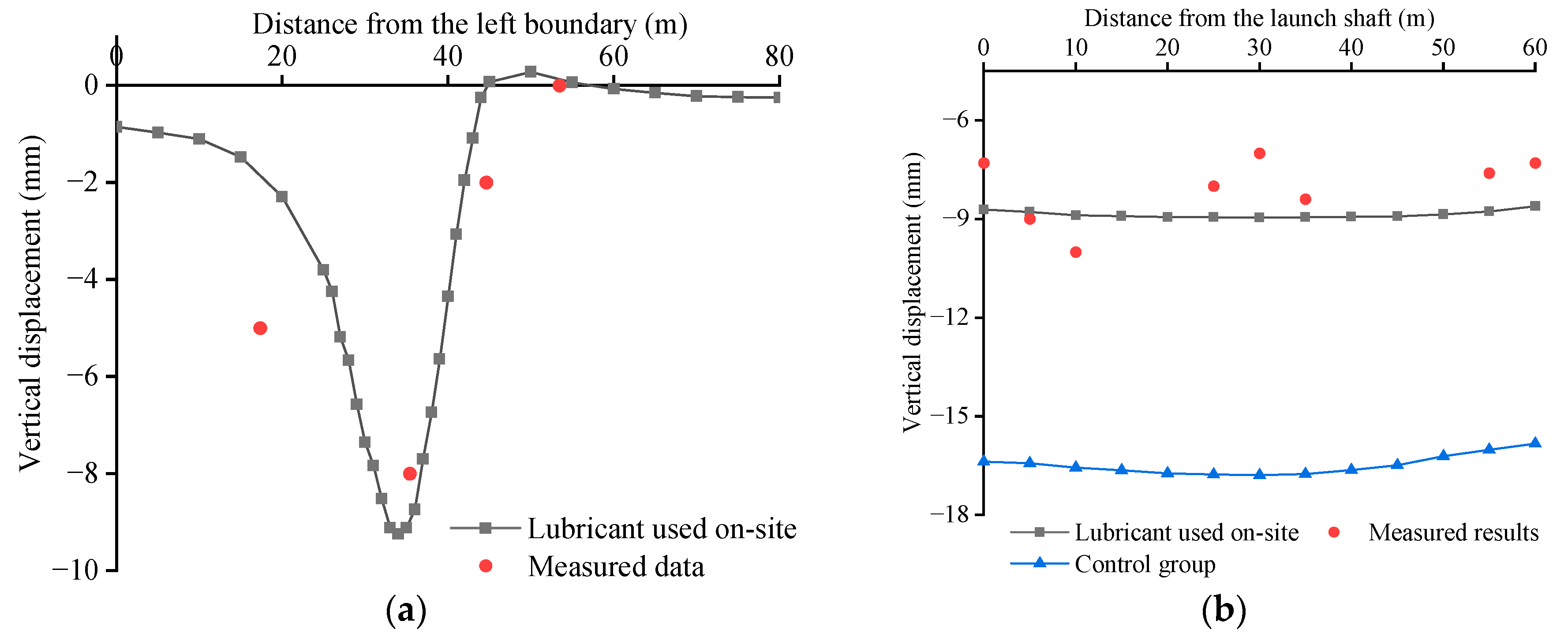
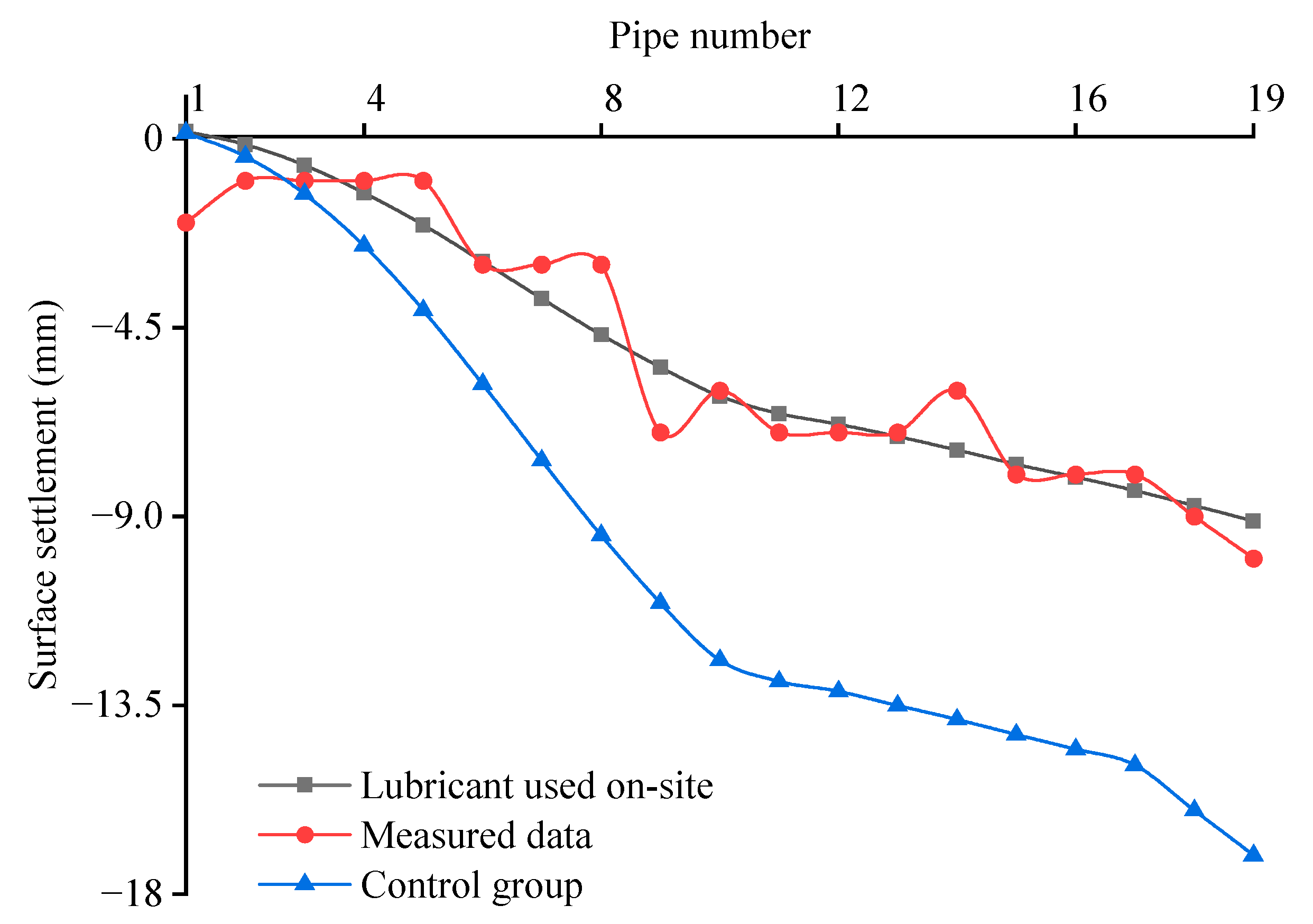

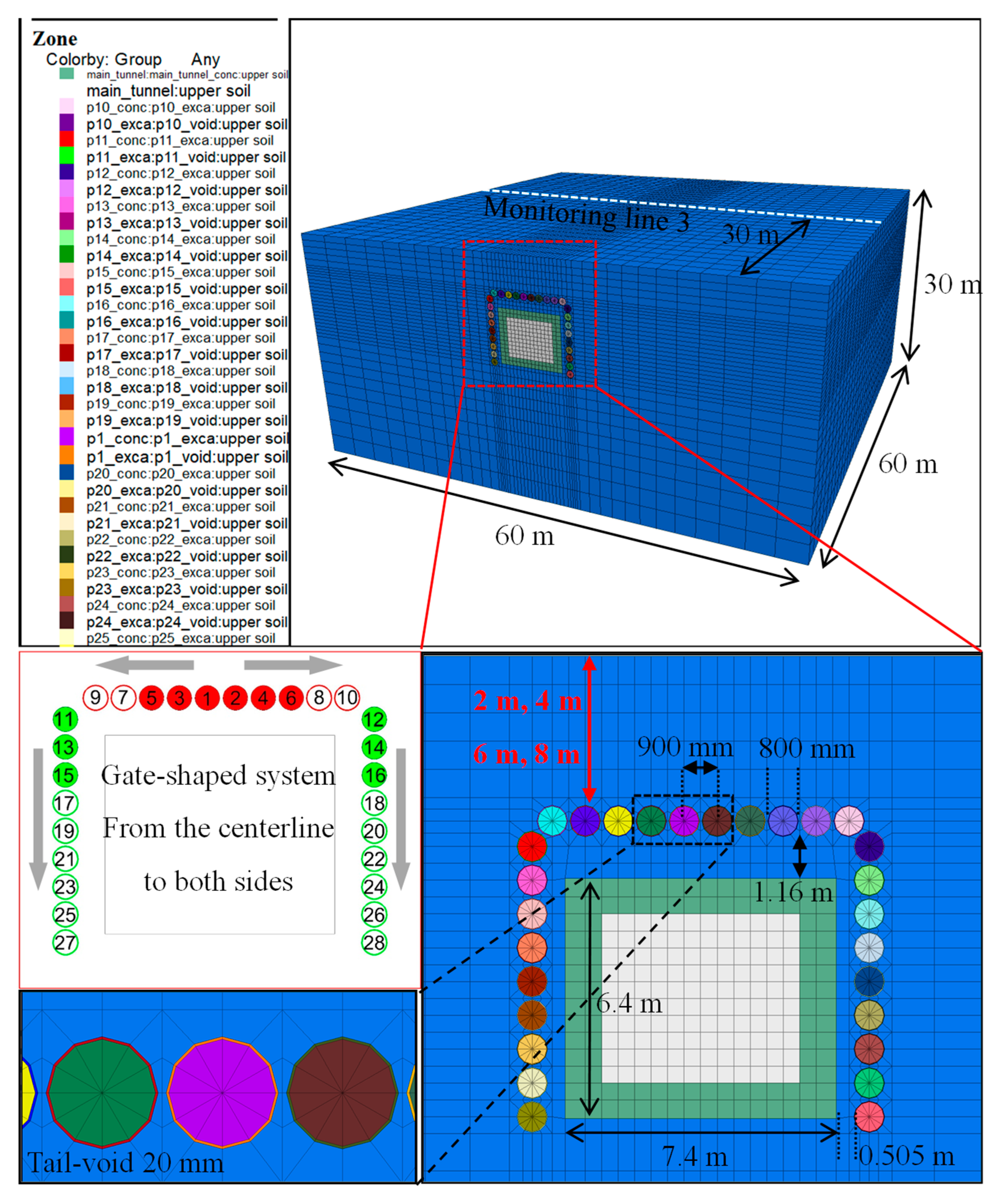
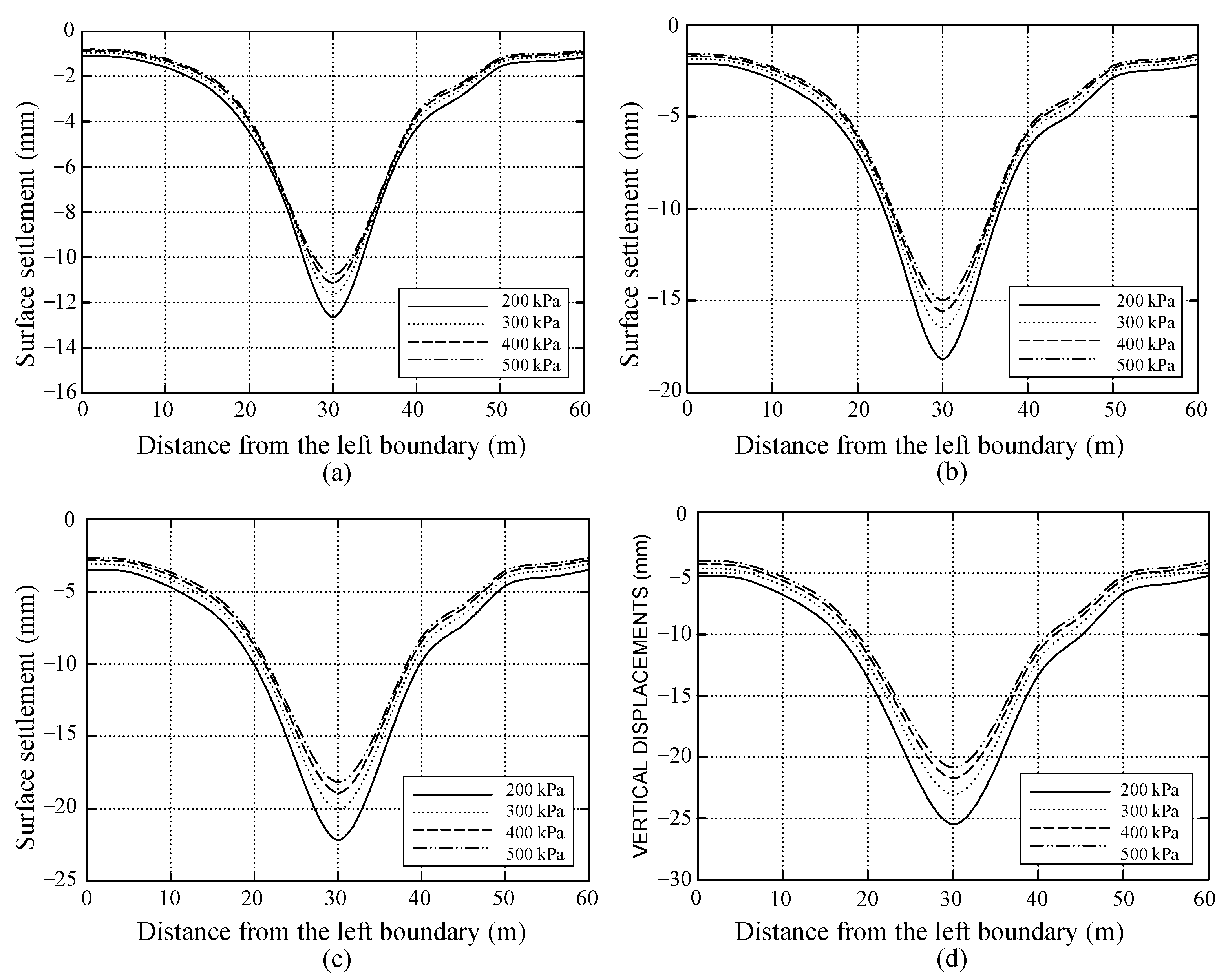
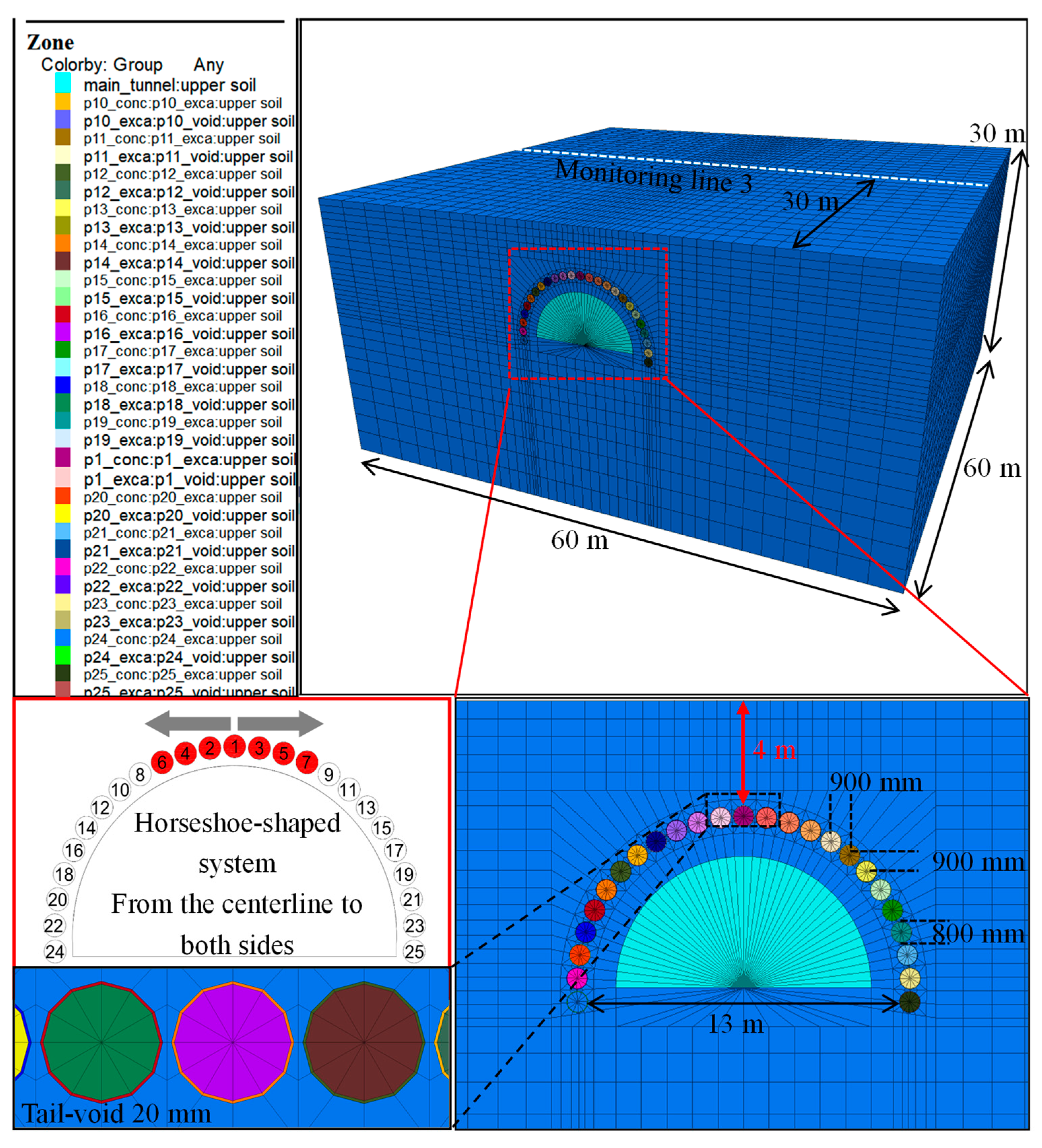

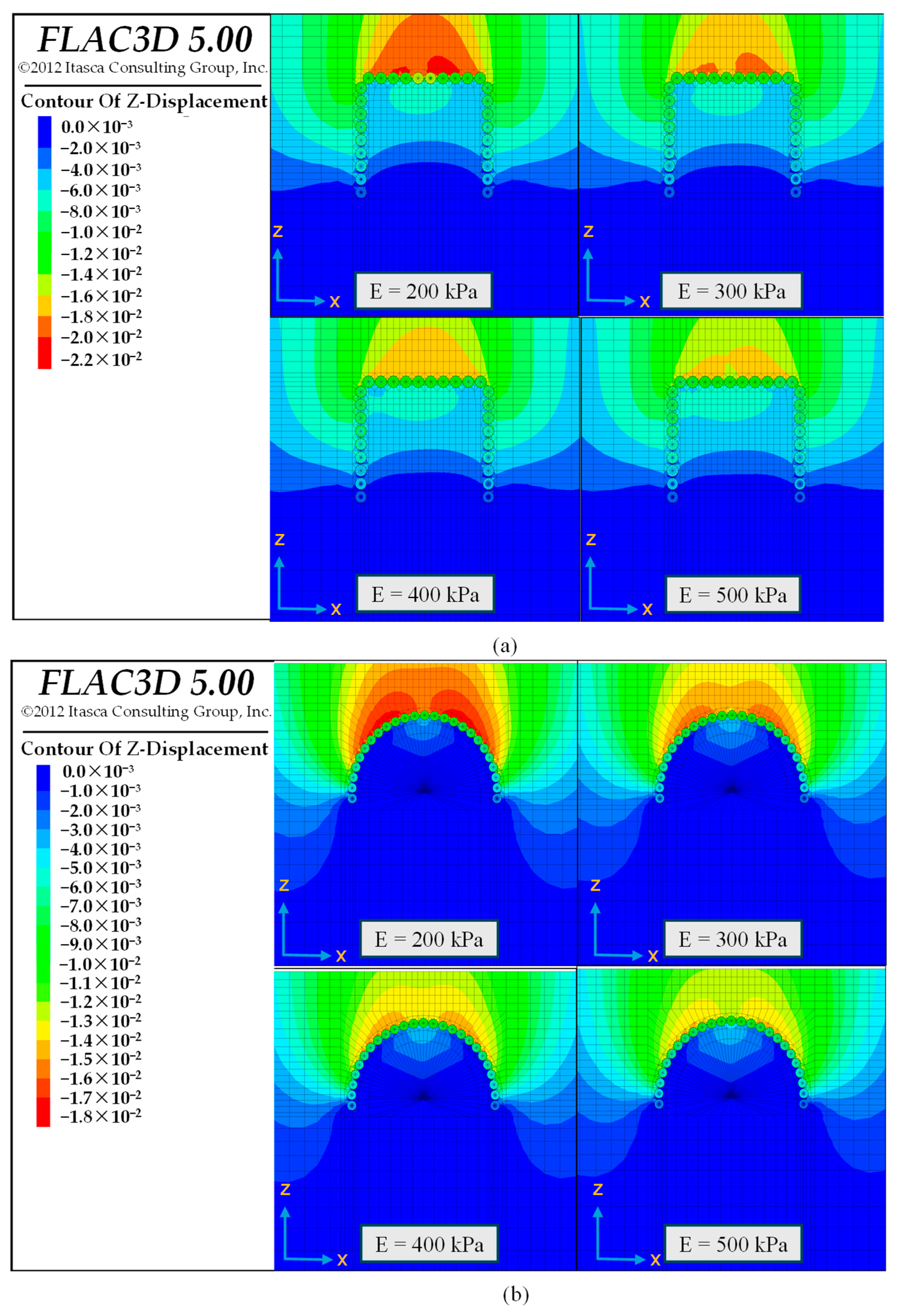
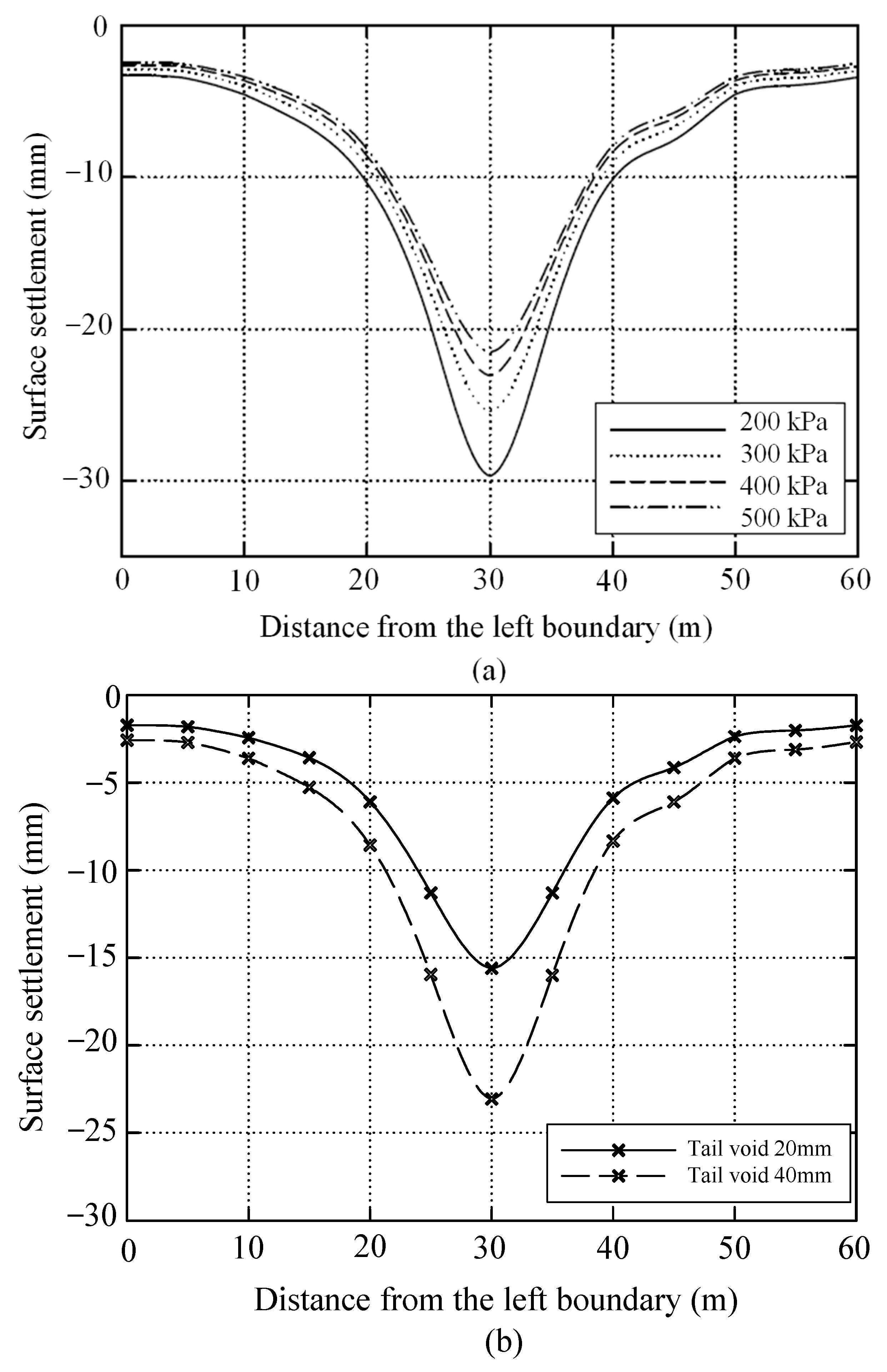
| Soil | Young’s Modulus (MPa) | Poisson’s Ratio | Friction Angle (°) | Cohesion (MPa) | Density (kg/m3) |
|---|---|---|---|---|---|
| Gravelly clay | 19.4 | 0.4 | 20.7 | 0.058 | 2000 |
| Clay | 16.9 | 0.35 | 11.7 | 0.042 | 1830 |
| Variables | Consolidation Time | Young’s Modulus (MPa) | Poisson’s Ratio | Density (kg/m3) | Thickness (mm) | Components |
|---|---|---|---|---|---|---|
| Lubricant used on-site | After injection | 0.1 | 0.49 | 2100 | 20 | Silicate minerals + Polymers + Fibers |
| 7 days | 0.23 | 0.4 | ||||
| 14 days | 0.32 | 0.4 | ||||
| 21 days | 0.37 | 0.4 | ||||
| 28 days | 0.40 | 0.4 |
| Type | Young’s Modulus (MPa) | Poisson’s Ratio | Density (kg/m3) | Thickness (mm) |
|---|---|---|---|---|
| Concrete | 22,000 | 0.2 | 2400 | - |
| Steel pipe | 210,000 | 0.25 | 210,000 | 12 |
| Modeling Scenarios | Modeling Cases | Burial Depth h (m) | Lubricant Input Parameters | Pipe Roof Arrangement | Tail Void (mm) | ||
|---|---|---|---|---|---|---|---|
| Young’s Modulus (kPa) | Poisson’s Ratio | Density (kg/m3) | |||||
| Scenario 1 | Case 1–1 | 2 | 200, 300, 400, 500 | 0.4 | 2100 | Gate-shaped system (28 pipelines) | 20 |
| Case 1–2 | 4 | ||||||
| Case 1–3 | 6 | ||||||
| Case 1–4 | 8 | ||||||
| Modeling Scenarios | Modeling Cases | Burial Depth h (m) | Lubricant Input Parameters | Pipe Roof Arrangement | Tail Void (mm) | ||
|---|---|---|---|---|---|---|---|
| Young’s Modulus (kPa) | Poisson’s Ratio | Density (kg/m3) | |||||
| Scenario 2 | Case 2–1 | 4 | 200 | 0.4 | 2100 | Horseshoe-shaped system (25 pipelines) | 20 |
| Case 2–2 | 300 | ||||||
| Case 2–3 | 400 | ||||||
| Case 2–4 | 500 | ||||||
| Modeling Scenarios | Modeling Cases | Burial Depth h (m) | Lubricant Input Parameters | Pipe Roof Arrangement | Tail Void (mm) | ||
|---|---|---|---|---|---|---|---|
| Young’s Modulus (kPa) | Poisson’s Ratio | Density (kg/m3) | |||||
| Scenario 3 | Case 3–1 | 4 | 200 | 0.4 | 2100 | Gate-shaped system (28 pipelines) | 40 |
| Case 3–2 | 300 | ||||||
| Case 3–3 | 400 | ||||||
| Case 3–4 | 500 | ||||||
Disclaimer/Publisher’s Note: The statements, opinions and data contained in all publications are solely those of the individual author(s) and contributor(s) and not of MDPI and/or the editor(s). MDPI and/or the editor(s) disclaim responsibility for any injury to people or property resulting from any ideas, methods, instructions or products referred to in the content. |
© 2025 by the authors. Licensee MDPI, Basel, Switzerland. This article is an open access article distributed under the terms and conditions of the Creative Commons Attribution (CC BY) license (https://creativecommons.org/licenses/by/4.0/).
Share and Cite
Zhang, S.; Sasaoka, T.; Hamanaka, A.; Hu, X.; Ma, P.; Shimada, H. Effect of Lubricant Young’s Modulus on Surface Settlement Control During Pipe-Roof Construction Using Pipe-Jacking Method. Appl. Sci. 2025, 15, 3713. https://doi.org/10.3390/app15073713
Zhang S, Sasaoka T, Hamanaka A, Hu X, Ma P, Shimada H. Effect of Lubricant Young’s Modulus on Surface Settlement Control During Pipe-Roof Construction Using Pipe-Jacking Method. Applied Sciences. 2025; 15(7):3713. https://doi.org/10.3390/app15073713
Chicago/Turabian StyleZhang, Shuai, Takashi Sasaoka, Akihiro Hamanaka, Xiaohu Hu, Peng Ma, and Hideki Shimada. 2025. "Effect of Lubricant Young’s Modulus on Surface Settlement Control During Pipe-Roof Construction Using Pipe-Jacking Method" Applied Sciences 15, no. 7: 3713. https://doi.org/10.3390/app15073713
APA StyleZhang, S., Sasaoka, T., Hamanaka, A., Hu, X., Ma, P., & Shimada, H. (2025). Effect of Lubricant Young’s Modulus on Surface Settlement Control During Pipe-Roof Construction Using Pipe-Jacking Method. Applied Sciences, 15(7), 3713. https://doi.org/10.3390/app15073713





